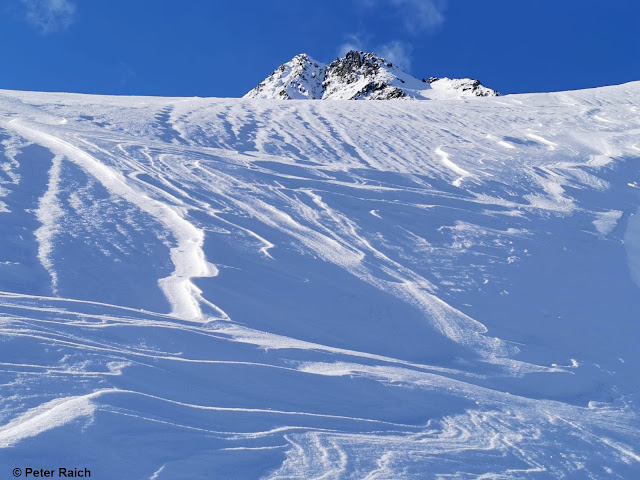In North Tirol, a treacherous old-snow problem regionally, particularly on north-facing slopes above approximately 2200 m
Avalanches in the last few days involving people, together with our own snowpack analysis, confirm a quite treacherous old-snow problem in some regions. It is most pronounced in the northwestern regions of North Tirol where there has been little snow since the beginning of December. The threat in this regions is considerable above approximately 2200 m. Avalanche prone locations are found above 2200 m on north-facing slopes in particular, above about 3000 m also in other aspects. Threatened are zones where prior to the December snowfall there was already snow on the ground and where area-wide, loosely-packed weak layers formed.
 |
Danger-level map for Friday, 18.12.2020. Considerable danger due to old-snow problem.
|
Avalanches of the last few days (old-snow problem)
On 12.12.2020 a slab was observed near Rietzer Grieskogel in Sellraintal on a very-steep NW slope at about 2500 m. Tracks were seen leading into the avalanche and out of it.
 |
Slab avalanche Rietzer Grieskogel (photo: 12.12.2020)
|
On 14.12.2020 a slab avalanche triggered below the Kübelwände in the Muttekopf region near Imst while someone was descending the slope. The person was able to ski out of the avalanche. The terrain was very-steep at minimum, E-NE aspect, the fracture occurred at about 2600 m.
 |
| Slab on the Kübelwände. The avalanche triggered during the person’s descent where there was snow from early winter which was significantly faceted in places, orographically right, near the rock wall. (photo: 16.12.2020) |
 |
A snow profile near the Kübelwände fracture reveals the brighter mass of fresh snow (beginning of December) and the darker old snow mass. Just below the fresh snow is a loosely-packed, expansively metamorphosed layer: the relevant weak layer for the slab. (photo: 16.12.2020)
|
On 14.12 a backcountry skiier died on the Vorarlberg side of the Tirolean border region while descending from the Albonagrat above Stuben. Altitute 2300 m, northern aspect, at least very-steep.
On 15.12 two backcountry skiers triggered a slab avalanche below the Hintere Grieskogel during their descent from Pirchkogel. One person was swept along but was not injured. NE, 2700 m, very-steep to extremely-steep terrain.
 |
At the center of the fracture, the two skiers’ entry tracks are visible. (photo: 17.12.2020)
|
 |
Snow profile for the slab avalanche on Hinterer Grieskogel: location above the fracture near the ridgeline. The very soft layer consisting of loosely-packed depth hoar and faceted crystals formed the weak layer for the slab. It proved quite easy to initiate a fracture there, which then propagated.
|
On 17.12, headquarters was informed of an avalanche in the Mattun (Arlberg region). As yet we do not have further details. What is certain: no one came to grief.
Ongoing glide-snow problem in regions with heavy snow
Glide-snow activity has decreased in the interim, but gliding snow masses still can be expected on steep, smooth ground. For that reason, we ongoingly recommend avoiding zones below glide cracks in the snowpack surface. The moment when glide-snow avalanches release is – our frequent mantra – impossible to predict.
 |
A risky place to stop: below glide-cracks. East Tirol. (photo: 10.12.2020)
|
Roads have repeatedly been buried by glide-snow avalanches, both in North Tirol and East Tirol wherever there is ample snow. Fortunately they have caused no damage. So far this season, damages from glide-snow avalanches have been limited. We know of a goods-cablecar for the Bonn-Matrei Refuge which was damaged.
 |
Encircled: the goods cablecar. Visible: the fracture of the glide-snow avalanche. (photo: 11.12.2020)
|
 |
Frequent glide-snow avalanches in some places in East Tirol (photo: 11.12.2020)
|
 |
| Snow gliding over the roof of a shed |
|
 |
Rooftop avalanche at Muttekopf Refuge. Visible in background: the glide-snow fracture, a ‘wishbone’ crack and a gliding-snow slide (photo: 16.12.2020)
|
 |
Impressive snow masses in Sillian (photo: 10.12.2020)
|
Also noteworthy:
The weather
Conditions were variable last week, with both northerly and southerly air currents. The rise in temperature starting on Monday, 14.12, was noteworthy.
 |
| The snowpack settled further. Frequently strong winds from varying directions, particularly on Main Alpine Ridge at high altitudes. Clearly visible: the temperature rise starting on 14.12.2020. |
Loosely-packed snow avalanches
 |
Frequent loosely-packed snow avalanches on 15.12 as a result of rising temperatures. Mieming Massif (photo: 17.12.2020)
|
 |
In the background: a loosely-packed snow avalanche in sunny, extremely-steep terrain. Schlick (photo: 16.12.2020)
|
Overall snow depths
 |
Snow distribution in Tirol: significant gradations from south to north. NW/NE regions have the least snow.
|
In regions with the most snow, the snowpack has settled and stabilized significantly. In some places there is still superb powder.
Apart from glide-snow avalanches referred to, positive aspects need to be emphasized. The snowpack has settled quite well, and stabilized. Winter sports enthusiasts are taking advantage of this situation and venturing frequently into extremely-steep terrain.
 |
Extremely-steep descent in East Tirol (photo:
|
Following the termination of the heavy snowfall on 09.12.2020 there was initially very deep powder, then powder-to-perfection for deep-snow skiing. In the interim, higher temperatures have decimated the powder at low and intermediate altitudes, as well as in general on sunny slopes. Currently there is melt-freeze snow or a moistened snowpack surface. On shady slopes there is still powder at higher altitudes.
 |
A dream come true: descent from Eselrücken in Virgental (photo: 12.12.2020)
|




















































